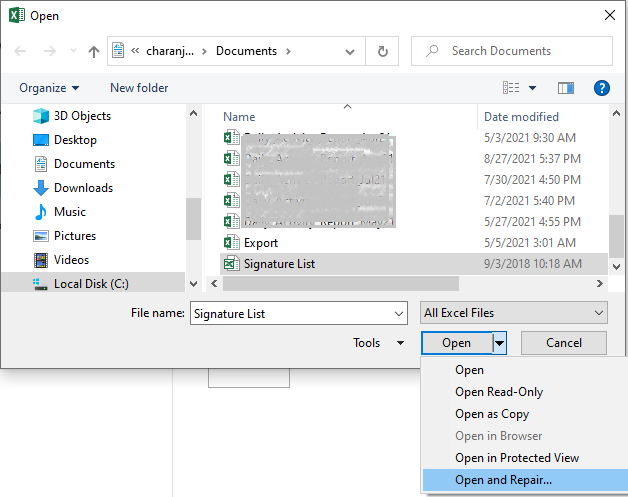The Ultimate Guide To Excel Links Not Working
Table of ContentsThe 4-Minute Rule for Excel Links Not WorkingA Biased View of Excel Links Not WorkingExcel Links Not Working Things To Know Before You BuyUnknown Facts About Excel Links Not WorkingSome Known Factual Statements About Excel Links Not Working

Range calculation features like either can not manage whole column referrals or determine all the cells in the column. User-defined functions do not immediately recognize the last-used row in the column and also, as a result, often calculate entire column recommendations inefficiently. It is easy to program user-defined functions so that they identify the last-used row.

Our Excel Links Not Working PDFs
Using the formula for a vibrant range is normally more suitable to the formula since has the disadvantage of being an unstable feature that will certainly be calculated at every recalculation. Performance reduces due to the fact that the function inside the dynamic variety formula have to analyze lots of rows. You can minimize this performance reduction by keeping the component of the formula in a different cell or specified name, and after that referring to the cell or name in the dynamic array: Counts!z1=COUNTA(Sheet1!$A:$A) Offset, Dynamic, Range=OFFSET(Sheet1!$A$ 1,0,0, Counts!$Z$ 1,1) Index, Dynamic, Range=Sheet1!$A$ 1: INDEX(Sheet1!$A:$A, Counts!$Z$ 1+ROW(Sheet1!$A$ 1) - 1,1) You can likewise utilize features such as to create vibrant ranges, yet is volatile and always calculates single-threaded.
Making use of numerous vibrant varieties within a single column requires special-purpose counting features. Utilizing numerous dynamic ranges can lower efficiency. In Office 365 version 1809 and also later on, Excel's VLOOKUP, HLOOKUP, as well as MATCH for specific suit on unsorted data is much faster than in the past when looking up numerous columns (or rows with HLOOKUP) from the very same table variety.
The good news is, there are lots of methods of improving lookup calculation time - excel links not working. If you use the specific suit option, the computation time for the function is symmetrical to the number of cells scanned prior to a match is located. For lookups over big arrays, this moment can be considerable. Lookup time using the Continue approximate suit options of,, and this also on sorted information is quick and is not dramatically boosted by the length of the array you are looking up.
Excel Links Not Working Things To Know Before You Buy
Make sure that you comprehend the match-type and also range-lookup choices in,, and also. The complying with code example shows the phrase structure for the function. MATCH(lookup worth, lookup array, matchtype) returns the largest suit much less than or equivalent to the lookup worth when the lookup variety is sorted ascending (approximate match).
The default alternative is approximate suit arranged rising. The complying with code example reveals the phrase structure for the and functions.
VLOOKUP(lookup value, table range, col index num, range-lookup) HLOOKUP(lookup worth, table variety, row index num, range-lookup) returns the largest suit less than or equivalent to the lookup worth (approximate match). Table variety should be sorted rising.
The Definitive Guide for Excel Links Not Working
If your information is arranged, but you want a specific suit, see Use two lookups for arranged information with missing worths. Attempt using the as well as operates rather of. Is a little faster (roughly 5 percent quicker), less complex, and also uses less memory than a combination of and, or, the extra versatility that as well as deal usually enables you to significantly save time.
The function is fast and is a non-volatile feature, which speeds up recalculation. The feature is likewise fast; however, it is a volatile feature, and also it often dramatically raises the time taken to refine the estimation chain.$A$ 2:$F$ 1000, SUIT(A1,$A$ 1:$A$ 1000,0),3) Due to the fact that specific match lookups can be slow-moving, think about the following options for boosting performance: Make use of one worksheet.
When you can, the information first (is rapid), as well as use approximate suit. When you need to use an exact suit lookup, restrict the variety of cells to be checked to a minimum. Use tables and also structured referrals or dynamic array names instead than referring to a lot of rows or columns.
Some Known Details About Excel Links Not Working
Two approximate suits are considerably faster than one specific match for a lookup over greater than a couple of rows. (The breakeven factor is about 10-20 rows.) If you can arrange your data but still can not make use of approximate suit because you can not make certain that the value you are searching for exists in the lookup range, you can use this formula: IF(VLOOKUP(lookup_val, lookup_array,1, look at more info True)=lookup_val, _ VLOOKUP(lookup_val, lookup_array, column, Real), "notexist") The first part of the formula functions by doing an approximate lookup on the lookup column itself.
VLOOKUP(lookup_val, lookup_array, column, Real) If the answer from the lookup column did not match the lookup value, you have a missing value, as well as the formula returns "notexist". Understand that if you seek out a value smaller than the smallest worth in the checklist, you obtain a mistake. You can handle this error by utilizing, or by including a tiny examination value to the list.
Beginning with Excel 2007, you can utilize the feature, which is both simple as well as quick. IF IFERROR(VLOOKUP(lookupval, table, 2 FALSE),0) In earlier variations, an easy yet slow-moving way is to use a function that includes two lookups. IF(ISNA(VLOOKUP(lookupval, table,2, FALSE)),0, _ VLOOKUP(lookupval, table,2, FALSE)) You can stay clear of the dual specific lookup if you make use of specific as soon as, save the lead to a cell, and afterwards test the outcome prior to doing an.